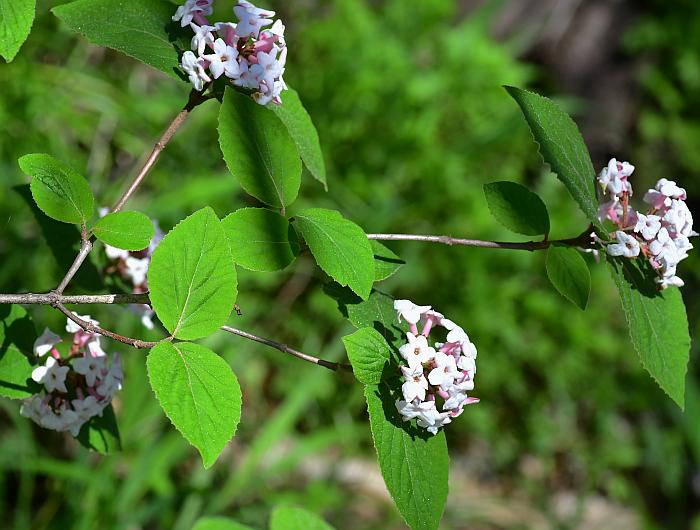Viburnum carlesii Hemsl.
Korean Spice Viburnum

Introduced
CC = *
CW = 0
MOC = 0
© SRTurner
Viburnum carlesii Hemsl.Korean Spice Viburnum | |
 |
Introduced CC = * CW = 0 MOC = 0 |
© SRTurner |
|
Family - Caprifoliaceae Habit - Deciduous shrub to 3 m. Stem - Twigs of current year moderately to densely pubescent with branched hairs and fascicles of hairs. Twigs of previous year glabrous, with small, rounded lenticels. Bark of older stems brownish grey. Winter buds naked, grayish stellate-pubescent.
Leaves - Opposite, simple, petiolate. Leaf blade planes typically canted relative to petiole. Petioles 4-12 mm, grayish stellate-pubescent. Blades ovate to elliptic-ovate, 4-10 cm long, 2-6 cm wide, rounded or slightly cordate at the base, pointed at the tip, the margins toothed, the upper surfaces sparsely pubescent with simple and stellate hairs, the lower surfaces more densely stellate-pubescent, particularly along the veins. Venation usually with 4-5 pairs of lateral veins, these inconspicuous on the blade upper surface, expressed and prominent on the lower surface, pinnate, slightly arched, branched.
Inflorescences - Terminal compound umbels up to 6 cm in diameter. Peduncles 1-4 cm, densely stellate-pubescent. Bracts leaflike, ovate to elliptic, stellate-pubescent, shed early. Individual flowers on 2nd or 3rd order rays, the pedicels very short.
Flowers - Fragrant. Calyces partially fused, the tube 0.7-1.0 mm, the 5 lobes 0.5-1.0 mm, rounded, glabrous. Corollas actinomorphic, trumpet-shaped, pale pinkish to white, the tubes 8-10 mm long, the expanded portion of the corolla 1 cm in diameter, the 5 lobes abruptly spreading, somewhat irregular, rounded, the margins entire. Stamens 5, adnate to the middle of the corolla tube, the anthers yellow, positioned near the throat of the corolla. Ovary semi-inferior, with 3 locules, two sterile and one fertile with a single ovule. Styles short, peglike, with a weakly capitate stigma.
Fruits - Elliptic, single seeded drupe, 1.1-1.4 cm, glabrous, turning red and then black. Flowering - March - April. Habitat - Open to lightly shaded, disturbed areas. Often cultivated. Origin - Japan, Korea. Lookalikes - Buddleja davidii, other species of Viburnum. Other info. - This attractive shrub is often cultivated, but rarely escaping in North America. The plant is recognized by its toothed, ovate leaves, the characteristic clusters of branched hairs on young twigs and leaf undersides, and the snowball flower clusters at the ends of branches. The flowers are very fragrant. The flowers have long corolla tubes, unlike other Missouri species of Viburnum. Photographs taken along Katy Trail near Treloar, Warren County, MO, 4-9-2021 (SRTurner). |